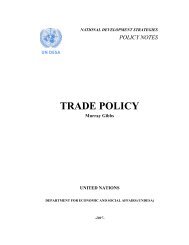SCP in Agriculture and Rural Development
SCP in Agriculture and Rural Development
SCP in Agriculture and Rural Development
You also want an ePaper? Increase the reach of your titles
YUMPU automatically turns print PDFs into web optimized ePapers that Google loves.
system custodians) <strong>in</strong> order to achieve successful results. Possible measures <strong>in</strong>clude the follow<strong>in</strong>g:<br />
(a) Allocation of property rights to water consum<strong>in</strong>g agents; (b) Water bank<strong>in</strong>g (to support<br />
economically beneficial re-allocations <strong>in</strong> times of water scarcity); (c) Tradable permits 10 ; <strong>and</strong> (d)<br />
Sal<strong>in</strong>ity control <strong>and</strong> dra<strong>in</strong>age management (e.g. Re-use of dra<strong>in</strong>age water on salt-tolerant crops;<br />
Dra<strong>in</strong>age water treatment). 11<br />
F<strong>in</strong>ally, governments should consider promot<strong>in</strong>g organic farm<strong>in</strong>g systems. Organic agriculture has<br />
a smaller footpr<strong>in</strong>t on the natural resource base, ecosystems <strong>and</strong> the health of agricultural workers<br />
than conventional agriculture. In addition, it provides for an environmentally sound <strong>and</strong> affordable<br />
way for smallholders to <strong>in</strong>tensify production <strong>in</strong> marg<strong>in</strong>al areas <strong>and</strong> offers promis<strong>in</strong>g export<br />
opportunities for develop<strong>in</strong>g countries which have <strong>in</strong> many cases an <strong>in</strong>herent comparative<br />
advantage due to relatively abundant labour supply <strong>and</strong> relatively low use of agro-chemicals.<br />
Several studies show that the use of organic methods of farm<strong>in</strong>g by small producers <strong>in</strong> develop<strong>in</strong>g<br />
countries can le ad to an <strong>in</strong>crease <strong>in</strong> yields <strong>and</strong> thus <strong>in</strong>crease food security among the poor. The<br />
potential to reverse the bias aga<strong>in</strong>st smallholders embedded <strong>in</strong> the model emphasiz<strong>in</strong>g purchased<br />
<strong>in</strong>puts as opposed to the assets that farmers already possess (low opportunity costs of labour) is<br />
another positive aspect associated with organic methods of farm<strong>in</strong>g. 12<br />
The ability to enter such profitable markets presents however significant challenges for producers,<br />
especially those <strong>in</strong> develop<strong>in</strong>g countries, <strong>in</strong>clud<strong>in</strong>g the fact they are relatively small <strong>in</strong> terms of<br />
traded volumes <strong>and</strong> that they require substantial <strong>in</strong>vestments <strong>in</strong> develop<strong>in</strong>g certification bodies <strong>and</strong><br />
secur<strong>in</strong>g re cognition for that certification <strong>in</strong> developed country markets. 13 Organic agriculture is<br />
furthermore fairly knowledge <strong>in</strong>tensive. Governments should support medium <strong>and</strong> small-scale<br />
producers through <strong>in</strong>stitutional <strong>and</strong> technical support.<br />
10 Pollution trad<strong>in</strong>g programmes have been very successful <strong>in</strong> other contexts, but less notable <strong>in</strong> water quality<br />
trad<strong>in</strong>g. There are however <strong>in</strong>terest<strong>in</strong>g lessons to be learned from several programmes <strong>in</strong> the United States, where<br />
most have been <strong>in</strong>itiated (e.g. the Long Isl<strong>and</strong> Sound Nitrogen Credit Trad<strong>in</strong>g Programme ; the M<strong>in</strong>nesota River<br />
Bas<strong>in</strong> trad<strong>in</strong>g system between po<strong>in</strong>t <strong>and</strong> nonpo<strong>in</strong>t sources; <strong>and</strong> the Tar-Pamlico River Bas<strong>in</strong> <strong>in</strong> North Carol<strong>in</strong>a<br />
trad<strong>in</strong>g programme . Summary <strong>in</strong>formation on current trad<strong>in</strong>g efforts <strong>in</strong> the U.S. related to water can be found <strong>in</strong><br />
http://www.epa.gov/owow /watershed/trad<strong>in</strong>g/trad<strong>in</strong>gactivities.html).<br />
11 Msangi, S., C. R<strong>in</strong>gler <strong>and</strong> M. Rosegrant (2006), “The future of agriculture <strong>and</strong> water: Market <strong>and</strong> policy-based<br />
strategies for susta<strong>in</strong>ability – What can the develop<strong>in</strong>g world learn from North America?”, <strong>in</strong> Water <strong>and</strong> agriculture:<br />
susta<strong>in</strong>ability, markets <strong>and</strong> policies, OECD.<br />
12<br />
76 WTO (2006), “Environmental requirements <strong>and</strong> market access – recent work <strong>in</strong> OECD <strong>and</strong> UNCTAD”, Note<br />
by the Secretariat, WT/CTE/W/244. See also Altieri, M.A., Rosset, P. <strong>and</strong> Thrupp, L.A. (2001), “The potential of<br />
agroecology to combat hunger <strong>in</strong> the develop<strong>in</strong>g world”, Ch.19 <strong>in</strong> The unf<strong>in</strong>ished agenda – Perspectives on<br />
overcom<strong>in</strong>g hunger, poverty, <strong>and</strong> environmental degradation, eds. P<strong>in</strong>strup-Andersen, P. <strong>and</strong> R. P<strong>and</strong>ya-Lorch,<br />
IFPRI, 302 pp.<br />
13 Rodrigues, M. <strong>and</strong> M. Torres (2003), La competitividad agroalimentaria de los países de América Central y el<br />
Caribe en una perspectiva de liberalización comercial, Serie Desarrollo Productivo No. 139, 64 pp.<br />
4 of 9
















